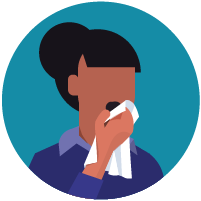COVID-19: Symptoms of Illness
Watch for Symptoms
Reported illnesses have ranged from mild symptoms to severe illness and death for confirmed coronavirus disease 2019 (COVID-19) cases.
These symptoms may appear 2-14 days after exposure (based on the incubation period of MERS-CoV viruses)
- Fever
- Cough
- Shortness of breath
Not everyone with COVID-19 has all of these symptoms. For many, symptoms are mild, with no fever. It is important to know that you can still spread (transmit) the virus to others even if you have mild or no symptoms.
COVID-19 is spread through respiratory droplets that are released when a sick (infected) person coughs, sneezes, or breathes. These droplets can remain in the air and on surfaces for an extended period of time. When people breathe in (inhale) the droplets, or touch surfaces that have been contaminated and then touch their mouth, face, or eyes, the virus can make them sick.
The CDC believes that symptoms of COVID-19 appear in as few as two days or as long as 14 days after contact with someone who has COVID-19.



When to Seek Medical Attention
Know emergency warning signs for COVID-19 and get medical attention immediately.
Emergency warning signs include * :
- Trouble breathing
- Persistent pain or pressure in the chest
- New confusion or inability to arouse (wake) a person
- Bluish lips or face
* This list is not all inclusive. Please consult your doctor or medical provider for any other symptoms that are severe or concerning.
Monitor Your Symptoms
If your illness is worsening (for example, if you have difficulty breathing), seek medical attention, but call first if you can.
- Call your doctor before going in: Before going to the doctor’s office or emergency room, call ahead if you can and tell them your symptoms. They will tell you what to do.
- If possible, take your temperature twice a day with a thermometer. A fever is typically a temperature of 100.4°F or greater. If you do not have a thermometer, symptoms of fever may including feeling unusually hot for no reason, having chills or having the sweats.
- Watch for fever, cough, or trouble breathing.
Wear a facemask: If possible, put on a facemask before you enter the building. If you can’t put on a facemask, try to keep a safe distance from other people—at least 6 feet away. This will help protect the people in the office or waiting room.
Follow care instructions from your health care provider and local health department: Your local health authorities will give instructions on checking your symptoms and reporting information.
Over-the-Counter Medication: There is no antiviral drug treatment for COVID-19, but individuals may want to consider over-the-counter (OTC) medications to relieve symptoms such as fever or muscle aches. Though there have been reports that ibuprofen (also called Advil or Motrin) may cause serious side effects among COVID-19 patients, we don’t have enough evidence to say whether this is true.
At this point, the World Health Organization is not recommending that people avoid ibuprofen when treating the symptoms of COVID-19. However, as we learn more about this issue, you may want to consider first using other OTC medications such as acetaminophen (also called Tylenol), as long as you do not have conditions such as liver disease that would make it unsafe for you.
Contact your doctor with questions regarding treatment of any symptoms.
Testing
Call your doctor if you have symptoms of COVID-19 and need medical care or think you are high risk for having a severe illness. Your doctor will determine whether or not you should be tested based on your symptoms, risk factors like travel or contact with others who are sick, and if you have underlying medical conditions.
Due to current shortages in testing supplies, not everyone with symptoms will be tested. If your symptoms are mild and can be managed at home, your doctor might recommend that you stay home under self-isolation to prevent the spread to others.
